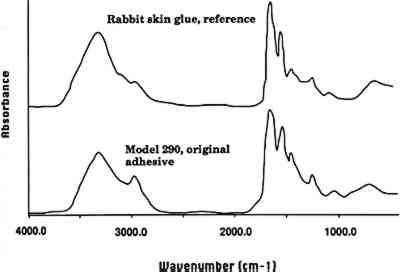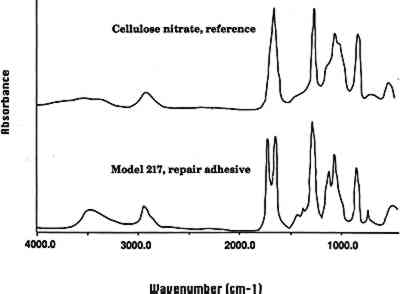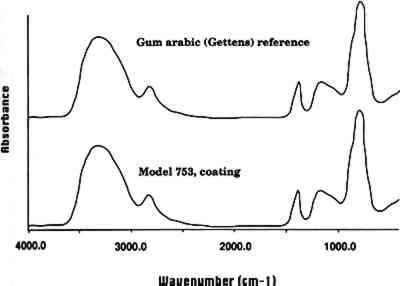THE HARVARD GLASS FLOWERS: MATERIALS AND TECHNIQUESRIKA SMITH McNALLY, & NANCY BUSCHINI
3 ADHESIVES AND COATINGS3.1 THE BLASCHKAS' ORIGINAL ADHESIVELetters from the Blaschkas to the Wares and to Goodale at the time the models were made suggest that an unnamed glue was used to adhere some parts of the models together. Visual examination and solvent tests of the adhesive used on three models (Phyllocactus ackermanni, Cestrum elegans, and Datura) indicate that this adhesive was hide glue. Fourier transform infrared (FTIR) microspectrometry (Baker et al. 1988) on samples removed from these three models indicated that the adhesive is proteinaceous. This result combined with the results of solvent tests led us to conclude that the adhesive is animal (or hide) glue (fig. 2, spectra 1). Since only three samples were available for analysis of the adhesive, it is certainly possible that Blaschkas also used other adhesives. However, visual examination indicates that the adhesive used in many of the models is probably an animal glue.
3.2 REPAIR ADHESIVEIn a general condition survey of the collection, a number of previous repairs were noted. Visual examination indicated that the repairs may have been made with a cellulose nitrate adhesive. Some of the repairs are clumsy, and excess adhesive, yellowed in color and containing air bubbles, is visible. The adhesive fluoresces yellow in ultraviolet light and is soluble in acetone. FTIR analysis of repair adhesive from the model C. elegans (model 217, 1891) confirmed that the adhesive is a cellulose nitrate (fig. 2, spectra 2). Given the dates when the models were made (1886–1936), it is possible that in some instances a cellulose nitrate adhesive was also used as an original adhesive. However, visual examination indicates that the original adhesive in many of the models is hide glue. Occasional repair of the models has continued, most probably using a range of modern adhesives.
3.3 COATINGSIn 1928, Mary Lee Ware visited Rudolph Blaschka in his workshop near Dresden to see how the models were made. In a letter written to Oakes Ames at the Botanical Museum, she noted that after Rudolph made the glass models and applied color by enameling them, he applied a varnish to the surface (apparently to give the models a more matte appearance, as the glass itself was glossy) (Ware 1928). We examined a leaf of the model Pitosporum tobira (model 753, 1913) and found that it had a matte varnish on the surface that was readily soluble in water. When a small area of coating was removed, the glass underneath was glossy. FTIR analysis indicated that this coating is a carbohydrate. The sample spectrum closely matched that of a reference sample of gum arabic (see fig. 2, spectra 3). Given its ready solubility in water and the FTIR results, this varnish is clearly a plant gum, most probably gum arabic.
A leaf of the 1929 golden pear was also examined. The coating on the leaf had a faint yellow fluorescence under ultraviolet light and was easily removable with acetone. Like the glass of P. tobira, the glass underneath the coating on this model is glossy. FTIR analysis of a sample of this coating did not give a definitive identification except that it appears to be a natural resin. There were spectral peaks similar to both dammar and copal reference standards, and we conclude that it is a natural resin. The analyses and visual examinations of the models indicate that many indeed have an organic coating applied to the surface, in most instances to make it more matte and give a more lifelike appearance of leaves, stems, and petals. The FTIR analyses of the two coatings agree with Mary Lee Ware's description of the application of varnish. Additional analyses may identify further coating materials. Given that the paint media identified included natural resins and hide glue (see sec. 4.1), it appears that the Blaschkas used a variety of organic media. |


